Pages That Need Review
MF1323.1197 Reel 39_0558
6
5
The Navajos, Apaches, Pueblo Indians, Yuman and Mohaves of New Mexico and the present Arizona have not had any grammar or dictionaries made of their [several?] languages. Only 200 word vocabularies are known of them, which are of little public or philological utility. Should therefore suggest the following points to accomplish this object, at little expense, through the agents and interpreters of the Indian Bureau among the different tribes of the territories mentioned.
1. That the Bureau have provided in blank in quarter form, 1000 to 1500 words in English with two or three pages of grammatical forms and the interpreters and agents of the different superintendencies be supplied with three or four copies for each language - the best interpreter in each to be employed - the forms may be of 20 to 50 pages.
2. These officers to be instructed to make them work or clean as possible, writing the Indian words very clearly - one copy of [illegible] to be kept in the Supts. off. as in New Mexico & Arizona and another copy sent to the Indian Bureau - The authors name, office and length evidence in the tribe, date etc. to be added & full name of [illegible]
7
6
3. The localities and names of the camps or villages of the nation or tribe, with any vestiges of ruins or hyerologlyphics, to be detailed on a pen and ink map, with ^[illegible] [illegible] from a central point, in Indian geographical terms.
4. The writer to give as much an account of the traditions, religion, feasts, dances, war songs, and present history, habits customs, cultivation, mode of life & if Christianized and when, and if under Christian instruction now, their numbers etc - particularly as to the half civilized Pueblos - of which there seems to be two nations or general languages, and if any known part or present connections with the Toltec or Nahuatlac- Aztec tribes of Mexico, as they (the Pueblos) seem to be of the Pino stock or affiliations. A detailed account of the Moquis is very much wanted: The Indian terms of 12 womans and 12 men names also to be taken down.
5. A more particular account of the Apache tribes inhabiting the head nation of the Gila, and of its branches the Rios San Francisco, and Salado etc. of which very little is known - (c.c. of the latter two series -) since the visit of De Niza and Coronado in 1540.
6. A Biographical catalogue of the more important papers and documents relating to the Pueblo and other New Mexican tribes to be 263
8
7
found in the Spanish archives in the Ter. Secretary's office at Santa Fe and at Tucson and if any works in their language, by the Catholic missionaries between 1580 and 1846 remain in the New Mexican & Arizona parishes either in manuscript or print, whether catechesis or dictionaries etc. or of histories of the country with their full titles. Many such works are still to be found in the missions and parish archives of Sonora, [illegible] and [illegible] as well as California.
7. The work of preparing a dictionary and grammar on the plan indicated is very simple to me who understand their language; of which is known to many Americans and New Mexicans; and at the furthest can be accomplished in a week - some of the Moqui villages cannot understand each other, and the differences should be noted. The learned world is very much interested in a fuller knowledge of the languages of the ante 1862 New Mexico, to show the affiliations between them and those of Central Mexico. Their neighbor the Pimas, extending on different dialects from western Chihuahua in the Sierra Madre to the Gulf of California, and from the Gila river to Calican in Sinaloa to wit the Pima, proper the Papayos, Opatos, Yarkis, Mayos, Coros, [Tarahumaras?] etc. [illegible] being about 100,000 [illegible]
8. It is suggested that when their manuscripts are received a the Indian Bureau, they be added to by the other accounts statistical, [b?] etc) -
9
8
lately printed in the reports of the Indian Bureau and Government works from 1846 to 1864, and published by the Government in volumes similar to those on Commercial relations. It is believed that the series of such work would become extremely valuable to all public offices if distributed in the two territories
This plan, if approve might in time be [illegible] to all the tribes (or agencies) of the Pacific state and territories.
Alexr. S Taylor
Santa Barbara, California 17 September 1863
To the Hon. Wm. P. Dole Commissioner of Indian Affairs Washington D.C.
When these mgs. are read in Washington, of the little is given either in the Ind. Bureau reports or the Smithsonian reports, inquirers interested in Indian Affairs and [scientific?] persons will be informed of their receipt, so that if not printed by the Bureau, they will still confer a great honor on its library, influence and office.
A carefully drawn up and special account of the Pueblo Indian tribes is a very great [illegible] and any [illegible] in New Mexico competant to perform such a work and to make a map of their country with sets of its views ruins and heiroglyphics would confer a great honor in your name - no such work is known.
10
9 [Left]
Daily Evening Bulletin.
TUESDAY EVENING, SEPTEMBER 8, 1863.
New Works on the Indian Languages of California and Sonora.
Mr. Shea has lately issued two new numbers of his valuable series of the aboriginal languages relating to Indians of this coast, copies of which have just been received in California. The first is Grammar of the Pima, or Nevome–a language of Sonora, from a manuscript of the 18th century, (about 1785,) edited by Buckingham Smith, late Secretary of the United States legations to Spain and Mexico, 1 vol., 8vo. pp. 125. The work contains a catechism and confession in the Nevome language, of 31 pages, and a lengthy and well digested treatise on the grammatical structure of the aforesaid idiom. This curious and valuable essay was procured a few years ago by Mr. Smith, at Toledo, in old Spain. He assumes that it was made by one of the Jesuit missionaries, but this is evidently the work of one of their successors, a Franciscan, from its monastic motto. It seems to have been in use at the town of Movas or Mavis, in the Lower Pimeria, on the upper waters of the Rio Yaqui, not far from Ures, as appears from the 1855 map of Jacob Monk, of Baltimore. The Pima language, it seems from this work and other authorities of the Spaniards, extends from the northern parts of the State of Sinaloa to beyond and along the Gila river, to the river of [Tamo???] or Colorado, into South California (!) and west from the Sea of Cortes to the country of the Taraumaras, in the Sierra Madre of West Chihuauas. It included in its affiliations the Papagos, Opatas, Yaquis, Mayos, Pimas, Seris, Eudeves, Nevomes, Heves, and other less known populations, whose language is still recorded in the geographical terms of the States of Sonora and Sinaloa, and also of Arizona, and who are all assumed by later historians and philologists to have been intruders from more northern countries. The Moquis and Zunis seem to be related to them. At the present time they are wild [illegible] [illegible] [illegible] 70,000 souls ; but in 1750 they were estimated at double that number. This language covers one of the most extensive districts of North America, and its populations, when first known to the Spaniards, about 1535, were nearly all found to be cultivators of the soil, and living in scattered villages like the Pimas and Maricopas of the Gila in 1863. The history and character of the Pima nations, in connection with the Aztec chronicles of Mexico, has caused more discussion among the learned men of Europe and America than probably and other people on the continent.
[Right]
The second work of the series alluded to is A Volcabulary of the Language of the Mission of San Antonio in Alta California (sometimes called the Sextupays or Tetachoyas.) It is by Padre Buenaventura [Setjar?] of the Order of San Francisco with grammatical notes by the editor of the Series, who is one of the most distinguished of the Indian philologists. It occupies 72 octavo pages, and was compiled by the old Californian between 1772 and 1807, in which latter year he died at San Antonio Mission, in Monterey county. In 1823, this Mission, contained about 890 Indians ; but in 1863 you can hardly count a baker's dozen of them.
These two works are of great value in archaeological science, in showing the path of the ancient Indian invasions and migrations from north to south, and east to west. Though language is subject to great changes, it is yet permanent in its principles. The English language of to-day is widely different from the English language of the days of King Alfred, but still it is no other than the same Anglo-Saxon idiom, and by it, its speakers can be traced all through North Western Europe, and twisted up into all sorts of dialects in its shiftings and wanderings. Somer assert that the monks from Ireland first taught the Saxons and Britons the purer English, but this semms to be too much of bull to swallow without the horns. AST
MF1323.1197 Reel 39_0568
2
State of California - Department of State Sacramento, November 7th, 1863
Hon. Commissioner of Indian Affairs
Sir
Please find enclosed copy of concurrent Resolution passed by the Legislature of 1863 in this State relative to supplies furnished the Indian Reservations
Very Respectuflly AAH Tuttle Secy of State By CH [Consumming?] Deputy
MF1323.1197 Reel 39_0572
1
[illegible] Sacrameto, California November 4, 1863 [Alu.N.Julite?] Secretary of State The amenities en current Resolution of legislature of el Glato relative to scrappling furnished eigenthum hereof for [cho?] Indian Reservatory. Referred to this colonel Judicial Affairs [Haller Millouren?] Chief Clerk Dept of [illegible] Dec 1863 [hulua?] Saina Resolutions South to [section?] office and [illegible], after whom.
MF1323.1197 Reel 39_0576
3
D.I.O.I.A. March 24th 1863.
Sir,
Your letter of 4th December last has been considered in connection with A D Rightmires acc'ts for 1st & 2nd qr's 1861 and your own Prop= erty account in the six months ending Decr 31st 1861, and in reply thereto I have to state that you will be held strictly to account for the 61 mules, acknow= ledged by you as received from Mr R, in your Property Return.
As to two of them which you state you receipted for to him but dc'd not get, this is a matter between you and him.
In your letter of 14th August 1862 you state there are "three mules belonging to the Indian Department, which W Rightmire has not turned over to you, as per instructions from the Department of April 16th 1861;" and in your letter of 4th December last, you state "W R did turn over to you all the mules your receipt calls for except two;" and that the other one to which you referred was never turned over to you, but, as you are informed was purchased of one of Rightmires em= ployees
being a matter for the action of this office, you are required to transmit, said employees name here in order that in the event of any future [business with?] him [illegible[ this fact [may be at hand?] for reference
Yours Respectfully, Wm P Dole Commissioner,
J P H Wentworth Esqr Suptg Agent &c, San Francisco, California.
5
List of Employe's in the Southern Indian District of California, John. P. H. Wentworth, Supt. Agent during the Quarter ending September 30th 1862
Name Capacity State of Nativity and Whence Appointed Location Tribe for which appointed Services Commenced Amount of Annual Compensation Post Office Remarks Thos. Buschulte Supervisor Germany, San Francisco, Tejon Reserve 1861 June 5th 1800 " Los Angeles Wm. Pixley Do New York, Do, Tule River Farm " 5th 1800 " Tule River Transfered to Colorado, 1st July Alexr Godey Do Los Angeles Colorado Dist 1862 Jany 1st 1800 " Los Angeles, Transfered to [illegible] River [illegible] S. S. [Clapp?] Do Visalia, Tule River Farm July 1st 1800" Tule River C. B. Hermon Laborer Massachusettes, Los Angeles, Tejon Reserve 1861 June 19th 600" Los Angeles R. Wilson Do Denmark Tejon " " 1862 June 16th 600 " Do Discharged Sept 17th S. Peck Do Ohio Do " " July 1st 600" Do Discharged Sept 15th G. L. Hoffman Do New York Los Angeles " " July 9th 600" Do Transferred to Tule River Farm Nov 17', 18[6?] M. Wentworth Do Pennsylvania, S. [illegible] " " September 16th 600" Do [illegible] Harris Do Tule River Tule River Farm July 1sts 600 " Tule River Discharged July 31/62 Charles Strings Do Visalia " " " July 1st 600" Do Discharged Nov 8 of 62 A. Boschulte Do Pennsylvania, Tejon Tejon Reserve September 18th 600" Los Angeles W. Cosin Do New Jersey, Do Do September 15th 600" Do Henry F. Sampson Porter Maryland, San Francisco San Francisco June 1st 1861 120" San Francisco Discharged Sept 1st/62 John Homer Do Massachusettes Do " Do September 1st 1862 120" Do H. F. W. Hoffman Clerk Massachusettes Do " Do September 12th 1861 1500" Do
I certify on honor that the above statement is correct.
Jno. P. H. Wentworth Supt. Agent
6
List of Employe's in the Southern Indian District of California, John. P. H. Wentworth, Supt. Agent during the Quarter ending September 30th 1862
Name Capacity State of Nativity and Whence Appointed Location Tribe for which appointed Services Commenced Amount of Annual Compensation Post Office Remarks Thos. Buschulte Supervisor Germany, San Francisco, Tejon Reserve 1861 June 5th 1800 " Los Angeles Wm. Pixley Do New York, Do, Tule River Farm " 5th 1800 " Tule River Transfered to Colorado, 1st July Alexr Godey Do Los Angeles Colorado Dist 1862 Jany 1st 1800 " Los Angeles, Transfered to [illegible] River [illegible] S. S. [Clapp?] Do Visalia, Tule River Farm July 1st 1800" Tule River C. B. Hermon Laborer Massachusettes, Los Angeles, Tejon Reserve 1861 June 19th 600" Los Angeles R. Wilson Do Denmark Tejon " " 1862 June 16th 600 " Do Discharged Sept 17th S. Peck Do Ohio Do " " July 1st 600" Do Discharged Sept 15th G. L. Hoffman Do New York Los Angeles " " July 9th 600" Do Transferred to Tule River Farm Nov 17', 18[6?] M. Wentworth Do Pennsylvania, S. [illegible] " " September 16th 600" Do [illegible] Harris Do Tule River Tule River Farm July 1sts 600 " Tule River Discharged July 31/62 Charles Strings Do Visalia " " " July 1st 600" Do Discharged Nov 8 of 62 A. Boschulte Do Pennsylvania, Tejon Tejon Reserve September 18th 600" Los Angeles W. Cosin Do New Jersey, Do Do September 15th 600" Do Henry F. Sampson Porter Maryland, San Francisco San Francisco June 1st 1861 120" San Francisco Discharged Sept 1st/62 John Homer Do Massachusettes Do " Do September 1st 1862 120" Do H. F. W. Hoffman Clerk Massachusettes Do " Do September 12th 1861 1500" Do
I certify on honor that the above statement is correct.
Jno. P. H. Wentworth Supt. Agent

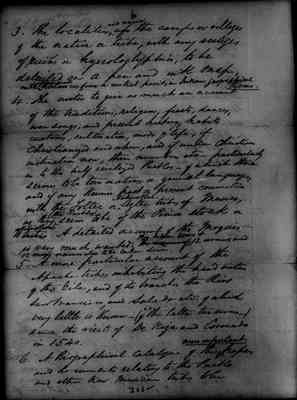

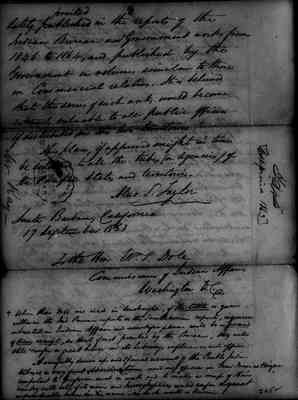
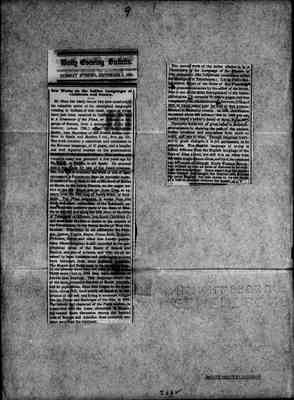
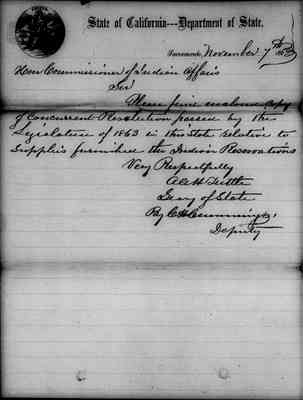

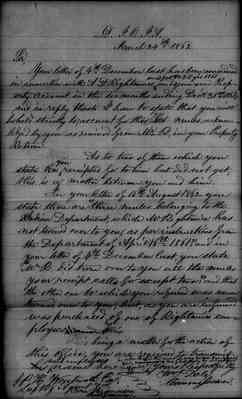

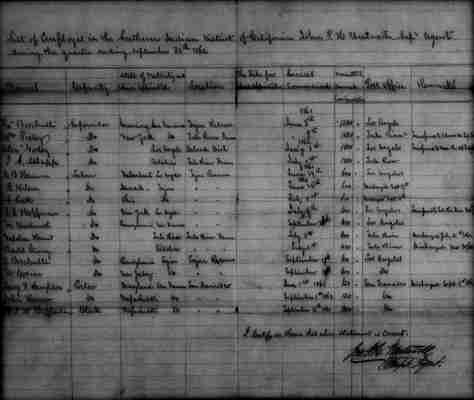
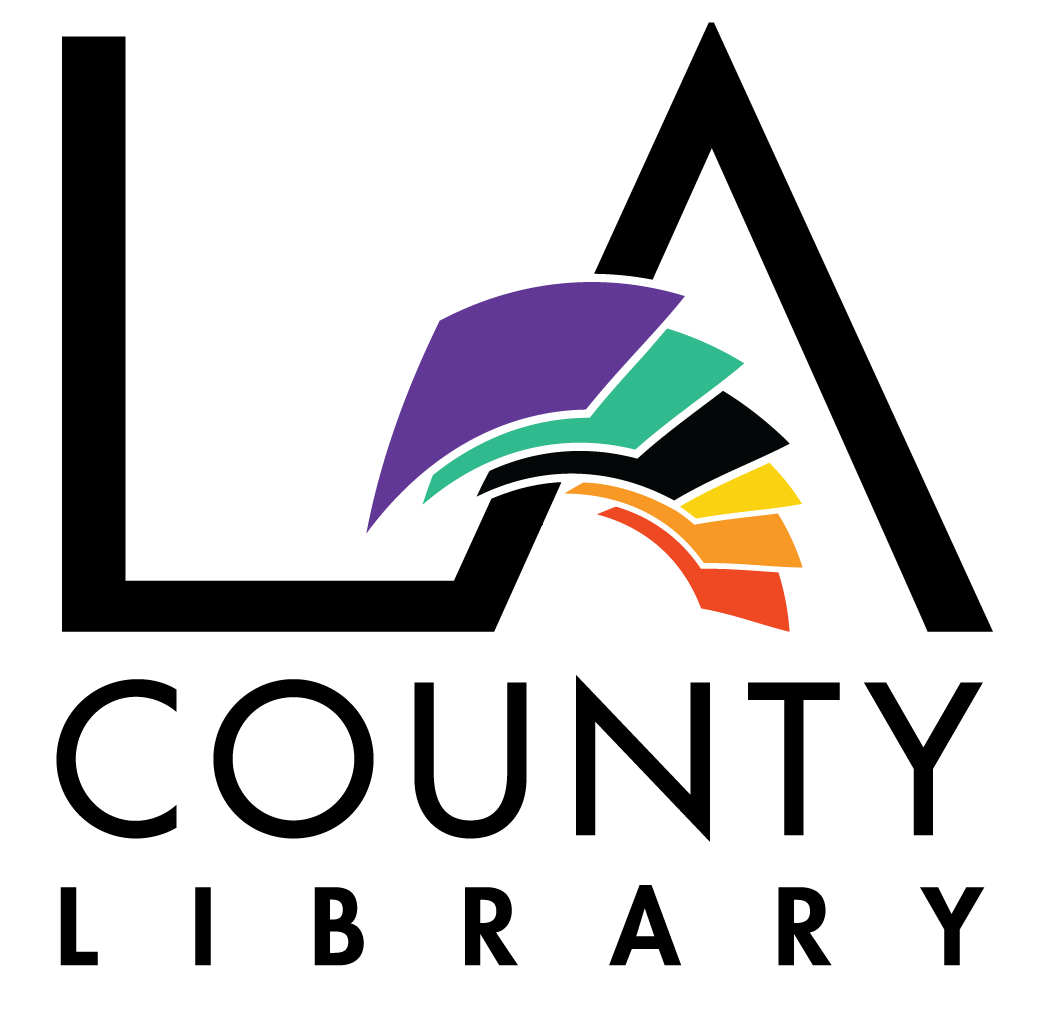

 /LACounty Library
/LACounty Library
